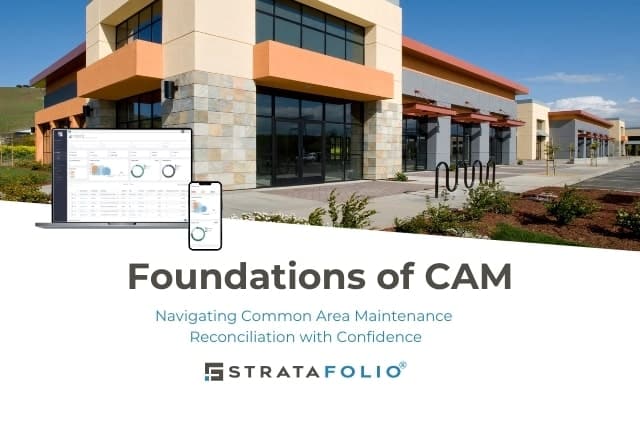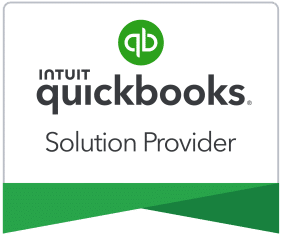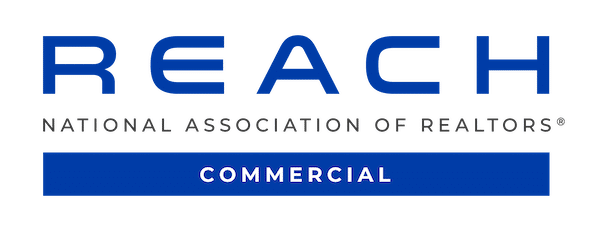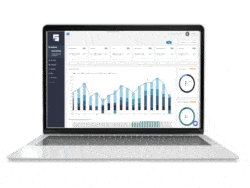
Learn about Common Area Maintenance (CAM) management, covering its significance, expense calculations, financial stability practices, and strategies to enhance tenant satisfaction.
Every day at STRATAFOLIO, we work with owners and managers of commercial real estate properties – office, retail, medical, strip malls, shopping centers, and industrial. Most of our clients with these assets have lease structures requiring annual Common Area Maintenance reconciliation activity, often called CAM. Through our collaboration with these clients, we see the areas where people have struggled. Because of this, we have assembled this guide to help others navigate the explicities of CAM.
Inflation and rising insurance costs impact almost everyone. In this context, effective Common Area Maintenance (CAM) management has become even more crucial for small to mid-size commercial real estate owners. CAM expenses, which include costs for maintaining lobbies, hallways, parking lots, and landscaping, are typically passed on to tenants based on their proportionate share of the leased space.
This guide will explore the critical components of CAM management, including how to calculate pro-rata shares, the implications of CAM caps, and the significance of timely reconciliation. We’ll also delve into the importance of accurately distinguishing between reimbursable and non-reimbursable expenses. Plus, how to avoid common pitfalls that can lead to financial discrepancies and tenant dissatisfaction. Owners can create a more stable and predictable financial environment by implementing disciplined budgeting practices and leveraging technology for efficient CAM management.
Ultimately, good processes and systems contribute to the long-term success of commercial properties, especially in the face of ongoing economic challenges.
Common Area Maintenance (CAM) charges – also referred to as CAM, CAM expenses, CAM charges, additional rent, and operating expenses – are the costs associated with maintaining the common areas of a commercial property. Such common area charges can include, but are not limited to:
In a gross lease, the owner is responsible for all operating expenses, so they charge a higher amount for the base rent. In a net lease environment, which we focus on in this guide, the tenant pays base rent plus an additional rent associated with operating the common areas. The base rent is lower, but the owner makes sure to cover the actual costs of the property.
Understanding CAM isn’t just about knowledge; it’s a tool to distribute maintenance costs among tenants equitably. This understanding creates transparency and trust, ensuring a harmonious relationship between owners and tenants.
Understanding the relationship between NNN leases, operating expenses, and budgeting is crucial for effectively managing CAM in commercial real estate. NNN leases require tenants to cover their share of property taxes, insurance, and maintenance costs, making it essential for owners to track and allocate these expenses accurately. By budgeting monthly expenses, you can anticipate and manage all operating costs efficiently, allowing for smoother CAM calculations and fewer financial surprises for either party. The following sections will guide you through the critical aspects of NNN leases, operating expenses, and the importance of disciplined budgeting in maintaining a well-managed property.
The big difference with commercial real estate is that the leases are typically Triple Net/NNN leases. Each N in a triple net lease represents a specific expense the tenant will pay their portion of.
The first “N” stands for Real Estate/Property Taxes, which tenants are often obligated to pay, even in ground lease situations.
The following “N” represents Insurance, such as the General Liability Insurance the landlord carries for the building. Typically, the lease will stipulate that this cost is shared between the landlord and the tenant, making it a standard expense for tenants.
The final “N” refers to Common Area Maintenance (CAM) or Operating Expenses. Understanding what CAM covers and what tenants are responsible for is crucial, as it often serves as a key negotiating point between tenants and landlords. Many large corporations have specific exclusions regarding CAM charges. All of these specifics should be clearly defined in the lease agreement.
Operating Expenses play a vital role in CAM for small to mid-size owners in commercial real estate. These expenses cover the upkeep and management of shared spaces, such as utilities, landscaping, security, and general maintenance.
The term Operating Expenses, or OpExp, is the term typically used to include all of the expenses the tenants will pay a pro-rata share of. This can include all three of the Ns in the NNN lease – property taxes, insurance, and CAM expenses. If they are paying even one of these expenses, it is called Operating Expenses.
Effective management of operating expenses is key to sustaining tenant satisfaction and long-term occupancy.
Reimbursable expenses are those the tenant has agreed to pay as a part of their lease. These costs, typically utilities, repairs, or other shared services, are passed on to tenants based on their pro-rata share. Accurately tracking and posting reimbursable expenses is necessary to ensure that all parties contribute fairly to the upkeep of the property.
Proper management of reimbursable expenses helps maintain the property’s financial health and creates transparency and trust between the owner and tenants. This reduces the likelihood of disputes and ensures a sustainable, well-maintained environment.
Non-reimbursable expenses cannot be passed on to tenants and must be absorbed by the property owner. These costs include certain capital improvements or other expenses excluded from tenant responsibility under their specific lease agreements. Understanding and carefully managing non-reimbursable expenses is crucial for maintaining profitability. When posting them to your accounting software, it is best practice to keep these expenses separate from those reimbursable.
This clear delineation leads to easier reconciliation at the end of the year. By effectively controlling these costs, owners can preserve the property’s value and maintain a positive cash flow, all while ensuring that tenant relationships remain strong and free from conflicts from being charged for expenses that are not reimbursable per the lease.
SMART EXPENSE TRACKING Technology systems can help owner-operators efficiently track and categorize reimbursable and non-reimbursable expenses, ensuring accurate billing and cost allocation. This automation reduces errors, enhances transparency, and enables better financial planning, ultimately supporting the overall profitability and sustainability of the property.
Budgeting monthly expenses is crucial for effectively managing CAM in commercial real estate. By carefully planning and tracking monthly costs, owners can better anticipate and allocate funds for the upkeep of shared spaces. This proactive approach ensures sufficient resources are available to cover necessary maintenance and repairs and helps set accurate CAM charges for tenants.
Establishing a budget for operating costs in a NNN (Triple Net) lease involves careful consideration of various factors. Here are some steps to help you establish a budget:
Once this budget has been established, you will track this budget throughout the year. Consistent budgeting allows for smoother financial operations, reduces the risk of unexpected expenses, and fosters transparency with tenants, ultimately contributing to a more predictable and stable operating environment.
A pro-rata share refers to a proportionate distribution or allocation of something, typically based on ownership or usage. In real estate, tenants often divide common area maintenance (CAM) expenses based on their pro-rata share of the total leasable square footage in a property. This means that each tenant pays a portion of the shared expenses proportional to their leased space in relation to the total rentable area. For example, if a tenant occupies 20% of the total rentable space in a building, they would be responsible for paying 20% of the CAM expenses of the building.
Accurately calculating the pro-rata share ensures that each tenant pays a fair and equitable portion of the operational costs. Properly managing the pro-rata share distribution is crucial to avoid disputes and ensure a fair financial burden among all tenants to maintain the building.
For the Pharmacy, take its 18,000 square feet and divide by 42,000 (total rentable sq. ft.). Next, take that number and multiply by 100. The pharmacy pro-rata share is 42.85%.
When entering into a commercial lease agreement, tenants and owners must understand the impact of negotiating the terms of the lease and adding caps to CAM. It is advisable to consult with a commercial real estate attorney or broker who can guide owners through the leasing process and help negotiate favorable CAM cap terms.
Owners and landlords should consider factors such as the initial CAM amount, the percentage of increase to the CAM amount, the frequency of cap adjustments, mechanisms for reviewing and calculating CAM expenses, how disputes regarding CAM expenses will be resolved if they arise, and any exclusions to the cap. The following section will break down CAM parts to help navigate these complexities.
In the context of CAM expenses, controllable expenses refer to costs that can be directly managed or controlled by the owner or manager. These typically include landscaping, cleaning services, and general maintenance. On the other hand, non-controllable expenses are costs that are generally outside of the property owner’s direct control, such as property taxes, insurance premiums, snow removal, and utilities. It is important to note that not every lease will specifically call out controllable or non-controllable expenses.
Decisions made at the management level of a property can often influence the controllable expenses. External factors such as government entities or weather typically determine non-controllable expenses. When CAM charges are calculated for tenants in a commercial property, both types of expenses may be included in the overall calculation to determine each tenant’s pro-rata share of these costs.
CAM caps limit the amount of CAM expenses a tenant is responsible for. If the total CAM expenses exceed the predetermined cap, the tenant does not need to pay anything over the stated amount. Often, these caps fall in the 3% to 10% range of increases annually.
CAM caps set a maximum limit on the amount a tenant is responsible for regarding their share of CAM expenses that are typically controllable, such as maintenance or utilities. These caps do not often apply to non-controllable expenses like property taxes or insurance. This is normally a negotiating tactic for the tenant to ensure that the CAM expenses do not significantly increase from one year to the next. Owners can specify different caps for each tenant based on the lease agreement and each kind of expense. This variability in tenant lease structures highlights the importance of using technology to track these details accurately. Errors introduced during CAM reconciliation can lead to disputes or even litigation.
CAM caps are essential for managing tenant costs, but they should be carefully applied to controllable expenses to maintain transparency and avoid potential disputes.
Percentage caps can be calculated on a cumulative or non-cumulative basis. A cumulative cap increases year over year at a steady rate regardless of the previous year’s actual increase in expenses. On the other hand, a non-cumulative cap means that the percentage cap must be applied based on the previous year’s actual increase in CAM expenses.
The Base Year in CAM calculations is the benchmark for determining a baseline for the tenant’s share of operating expenses. The year used for the Base Year should be stated in the lease. The total expenses spent by the owner in that period should be calculated using the pro-rata calculations applied. This is then the Base Year amount for future CAM reconciliation years for this lease. When a CAM reconciliation is done in the years after, the tenant will be responsible for their pro-rata share of the total expenses minus the base year expenses. This is typically only for CAM expenses but can also be used for property taxes and insurance, if specified in the lease.
By establishing a clear and accurate Base Year, owners ensure tenants are only responsible for expenses beyond the initial baseline and are complying with the lease agreement. However, this method can complicate future expense calculations and lead to disputes, so it’s often advisable to avoid using a Base Year when simpler, more straightforward cost allocation methods are available.
Cash Flow Issues: Delays in CAM reconciliation may require you to cover expenses out of pocket while waiting for tenant reimbursements.
Poor Record-Keeping: Incomplete or unorganized records can result in delays and billing discrepancies, leading to an inability to collect on all expenses or potential legal challenges.
Tenant Dissatisfaction: Late reconciliations can lead to disputes and strained relationships due to perceived poor management. Large lump sum invoices at the end of the year can also strain the finances of your tenants, which proper monthly budgeting can alleviate.
Reduced Profitability: Incomplete or delayed CAM management can force you to absorb costs unnecessarily.
Generally, CAM reconciliation must be provided to your tenants within 60, 90, or 120 days of the end of the year. Unfortunately, this activity also coincides with tax preparation time. However, failing to complete an accurate CAM reconciliation within the time outlined in the lease may mean losing the opportunity to recover any CAM shortfalls. The time that it takes to set up your processes now will save you money and time in the long run.
Timing is crucial for owners of small to midsize operations when managing CAM. Accurate and timely calculations, billing, and reconciliations of CAM expenses ensure that costs are fairly distributed and disputes are minimized. The longer it takes to do the CAM reconciliations, the longer it takes to get reimbursed for the expenses you have already paid for. This is time wasted and money out of your pocket that you could have used to purchase another property, re-invest in an existing property, or pay investor dividends.
The more structure and processes that you have in place to accomplish this task as soon as possible, the smoother the process will be. By adhering to a well-structured schedule, owners can maintain transparency, create trust with tenants, and ensure smooth financial operations. This ultimately contributes to their property management efforts’ long-term success and stability.
The CAM reconciliation process involves comparing the estimated CAM charges invoiced to tenants throughout the year with the actual expenses incurred by the property during the same time period. This process ensures tenants pay their fair share of the maintenance costs without overpaying or underpaying. Pulling reports in the third quarter is beneficial because it allows owners to identify discrepancies early, adjust estimates for the remainder of the year, and address potential issues before the year-end reconciliation.
A proactive approach to CAM reconciliation minimizes surprises for the owner and tenants, helps maintain accurate financial records, and ensures smoother year-end adjustments, ultimately establishing better tenant relationships and financial stability.
Partial-year CAM reconciliation occurs when a tenant occupies a space for only part of the year, requiring a proportionate calculation of their share of CAM expenses. This process ensures that the tenant pays only for the period they occupied the property rather than a full year’s expenses. Accurately calculating partial year CAM is essential to maintain fairness and avoid disputes, as it directly affects the tenant’s financial obligations.
Handling partial-year CAM requires careful tracking of the lease start and end dates and the expenses incurred during that period. Owners must adjust the tenant’s portion to reflect the tenant’s actual time occupying the property. This applies to CAM and all operating expenses, including real estate taxes and insurance. If this is done accurately when the tenant vacates the premises, this ensures that the owner covers their expenses. Delays in completing the final reconciliation increase the potential for the inability to recover any final shortfalls.
Software systems streamline the reconciliation process by automating calculations, tracking expenses, and ensuring accurate, timely adjustments, which reduces errors and simplifies CAM management.
A large part of managing commercial tenants successfully is having the right tools and processes in place.
To complete the CAM reconciliation process while using QuickBooks, it’s essential to identify and separate the costs associated with your CAM expenses. A well-organized Chart of Accounts (COA) is essential for efficient CAM management, ensuring clear differentiation between operating costs and reimbursable expenses. This clarity helps maintain a clean and efficient reconciliation process.
For example, not all maintenance can be passed on to the tenants, as most larger corporations will not pay for roof repairs. When posting these expenses, it is important to post them in a separate repair account for operations in your COA and not in the CAM or reimbursable accounts. This will ensure that the expense does not appear in the CAM Reconciliations at year-end.
Another example is when expenses are posted for Overhead or G&A costs. The utilities used in the space you occupy as the owner or manager are considered overhead expenses, which tenants do not cover and should be posted to the proper overhead account. However, the utilities used by tenant-occupied spaces are considered CAM or reimbursable expenses, meaning the owner should recover these costs from the tenants. These expenses are added to the CAM reconciliation at the end of the year for true-up.
By properly setting up your COA in QuickBooks, you can easily map out and track reimbursable expenses for each property or tenant. When it’s time for year-end CAM reconciliation, you can easily generate a report with separate reimbursable expenses. With this information, you can allocate the tenant’s pro-rata share more quickly while reducing the opportunity for error.
A well-organized Chart of Accounts in QuickBooks is the cornerstone of efficient CAM management, ensuring accurate and transparent expense tracking for seamless year-end reconciliation.
Delayed reconciliation in CAM management can significantly negatively impact both owners and tenants. When reconciliation is postponed, it often leads to cash flow issues, as owners may have to cover common area maintenance costs out of pocket while waiting for tenant payments. This delay can also create distrust among tenants, who may question the accuracy of late charges and feel blindsided by unexpected expenses. Additionally, postponed reconciliation increases the risk of billing errors, complicates financial planning, and can result in disputes or legal challenges. For more information on the impacts, check out the article: The Shocking Financial Impact of Neglecting CAM Reconciliation.
CAM reconciliation is typically due 60, 90, or 120 days after year-end, often overlapping with tax season. Missing this deadline can mean losing the chance to recover CAM shortfalls. Setting up efficient processes now will save time and money later.
Provided within this document are the foundations for getting started with managing CAM. You must surround yourself with the following:
Simply put, when owners meet their deadlines and proactively manage their CAM-related activities, the effort dramatically reduces the risk of ruining a tenant relationship and increases overall profitability.
In contrast, when not managed well, there are a series of cascading negative impacts, including a direct hit to the bottom line. This can make it more difficult to secure funding from a lender or attract future investors or tenants to occupy your available spaces.
Ensuring that all the elements are put in place will provide you with a competitive edge.
Our mission is to be the #1 provider of commercial real estate property management software for small-to-midsize commercial real estate owners.
STRATAFOLIO is an online software solution designed specifically for commercial real estate owners who use QuickBooks and want to streamline their operations to save time, increase profits, and reduce manual work. It empowers you to make data-backed business decisions with greater accuracy, providing a global view of your portfolio in a comprehensive dashboard. With STRATAFOLIO, you can confidently manage all aspects of your business—assets, finances, operations, and investors— all in one place.
Operations Management
Finance Management
Asset Management
Investor Management
Let us show you how STRATAFOLIO will optimize your real estate asset management with powerful analytics.
STRATAFOLIO Integrates Seamlessly with QuickBooks
The exact repairs and maintenance costs are difficult to calculate ahead of time. Common Area Maintenance (CAM) charges are estimated at the beginning of the year and divided into monthly payments for each tenant. Actual CAM charges are calculated at year-end—if the total is more than the tenant paid, the tenant pays the difference. If the total is less, the landlord is responsible for reimbursing the tenant for the difference.
CAM charges cover the cost of maintaining or repairing common areas shared by commercial tenants. This may include:
The CAM reconciliation process starts with identifying the costs associated with your common area maintenance and separating overhead costs from your recovery costs. For example, utility expenses are an overhead expense. While the tenant isn’t responsible for covering the costs directly, the owner/manager should be reimbursed or able to recover those specific expenses from the tenant.
STRATAFOLIO connects to QuickBooks to map your expenses and see how each reimbursable expense tracks against every tenant’s actual expenses. When it’s time to do CAM reconciliations at the end of the year, you can quickly and easily pull a report and share it with your client to recover expenses.
STRATAFOLIO is an online web-based, secure, mobile-friendly software application service made for people who own, manage or lease real estate and use QuickBooks Online or QuickBooks Desktop as their accounting software.
Yes. STRATAFOLIO currently integrates with both QuickBooks Online and QuickBooks Desktop. If you have another integration from another accounting system you would like us to consider, please send us an email so we can add you to our waiting list of future integrations.
Yes and no. Currently, STRATAFOLIO is not set up to do this without some modification. You can use the CAP feature and modify it on the report to make it a base year instead. We would be happy to show you how during Onboarding.
Every lease agreement outlines specific terms for these expenses, but typically, CAM expenses are based on the tenant’s pro-rata share. The CAM Reconciliation Report pulls in the actual amounts from your QuickBooks company file for each expense the tenant owes a share of. We then present this information to you with the share for those tenants. Once you verify the amount they paid for the year, you can easily true-up with the tenant for the year.
We set up your CAM Reconciliation Reports to match what you have already given to your tenants. If you would like, during the Onboarding process, we will review the report and suggest ways to make it more complete or easier for the tenant to understand.
No. We only display all of the transactions and reports on a cash basis across the entire platform.
Yes! We can add CAPs for each CAM subcategory per lease you have set up. We can add a percentage for year-to-year, a percentage over a given amount, a percentage up to a given amount, or a variation of ways. This calculates from year to year, so it is only entered once, and then you’re finished!
Yes! The CAM Reconciliation Report is designed to show the pro-rata share of the tenant based on the rentable square footage of the building.
Yes. We have added additional details so you can find the percentage of the Asset or Entity as well if needed. There are many ways to set this up depending on the structure of your QuickBooks and your portfolio.

Learn how you can keep using QuickBooks and save over 80% of manual effort when using STRATAFOLIO to manage your operations, global finances, assets, and investors. Utilize our two-way connection with QuickBooks to gain one fully integrated system.


Copyright© 2025 STRATAFOLIO, INC.

And, learn why other commercial real estate owners use STRATAFOLIO to increase efficiency and profitability.

Speak to an expert to find out how you can increase efficiency and profitability.